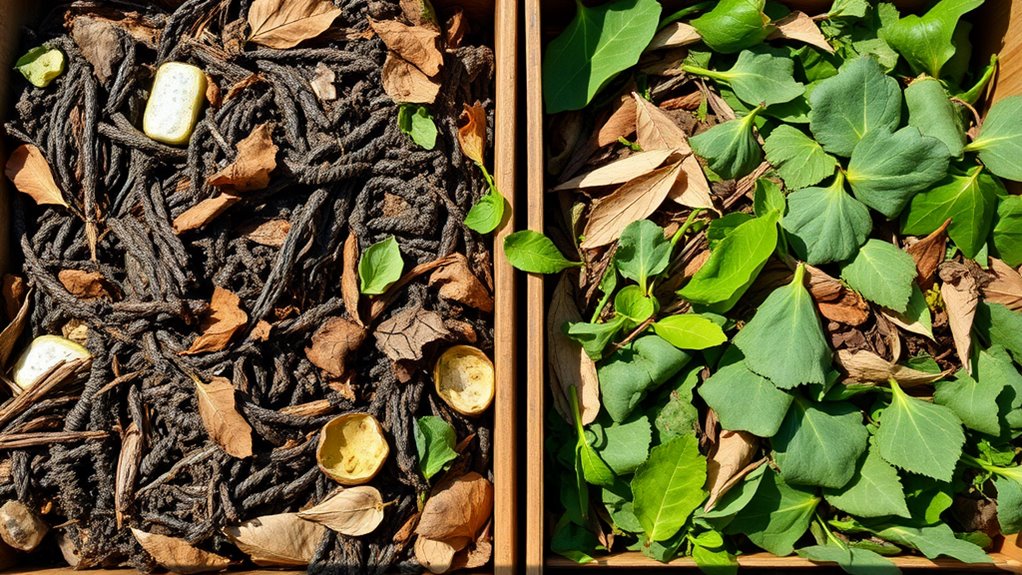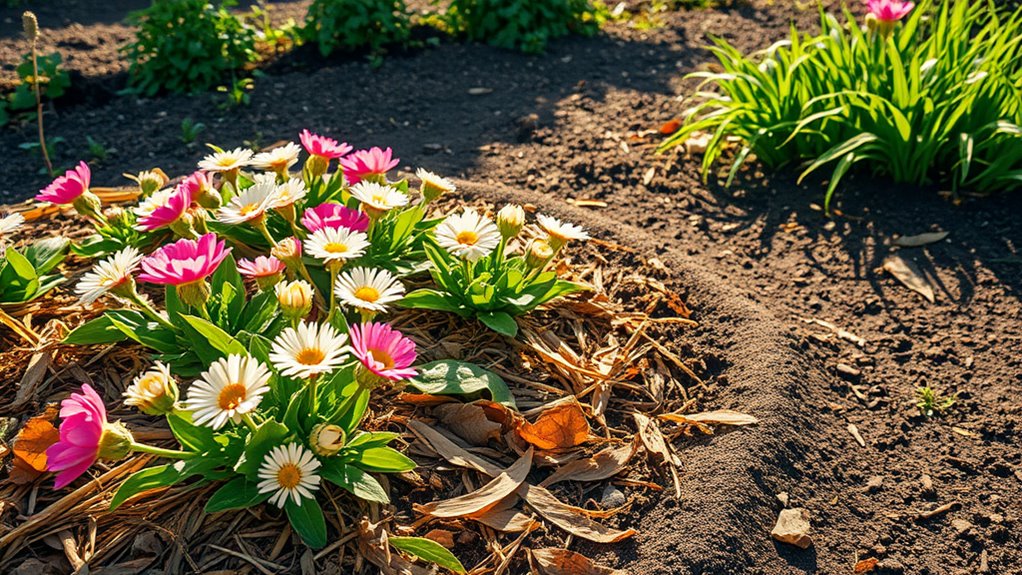5 Seasonal Tips That Keep My Garden Blooming All Year Long
To keep your garden blooming all year, you’ll start in spring by clearing debris, testing soil, and planting cool-season veggies like lettuce for vibrant growth. In summer, water deeply early in the day, apply mulch, and prune dead growth to beat the heat. During fall, harvest ripe crops carefully and enrich soil with compost for nutrient boosts. For winter, wrap sensitive plants in frost blankets and water before freezes to ensure survival. Year-round, layer 2-4 inches of mulch to maintain health—these strategies will help your blooms thrive even more.
Key Takeaways
- In spring, clear debris, amend soil with compost, and plant cool-season veggies for early blooms.
- In summer, water deeply in the morning and apply mulch to retain moisture and protect from heat.
- In fall, harvest ripe crops, add compost to soil, and plant cover crops for nutrient enrichment.
- In winter, wrap sensitive plants with frost blankets and water deeply before freezes to ensure survival.
- Year-round, use 2-4 inches of organic mulch to regulate soil temperature and suppress weeds.
Spring Preparation for Vibrant Growth
As spring emerges, you’ll kick off preparations by clearing winter debris and testing your soil to ensure it’s nutrient-rich and well-drained.
For year-round gardening, amend soil with compost to boost fertility, then plant cool-season veggies like lettuce and peas for early harvests.
Prune perennials and shrubs to encourage vigorous growth, and install supports for climbing plants.
Mulch beds to retain moisture and suppress weeds, setting a foundation for continuous blooms.
Monitor for pests early, using organic controls to maintain a healthy ecosystem that sustains productivity through the seasons.
By incorporating these methods, you are utilizing seasonal gardening secrets to ensure year-round success.
Additionally, apply universal soil prep techniques to adapt your garden to various environmental conditions for optimal plant health.
Summer Maintenance to Combat Heat
With summer’s heat intensifying, you’ll shift your focus from spring’s fresh growth to protecting plants from sun stress and dehydration. By incorporating expert watering techniques, gardeners can avoid common pitfalls like overwatering or shallow irrigation to maintain optimal hydration.
Implement smart strategies to keep your garden resilient, like deep watering and strategic shading to prevent wilting and promote vitality.
-
Water early and deeply: Saturate soil in the morning to reduce evaporation and reach roots effectively.
-
Mulch generously: Apply a 2-3 inch layer around plants to retain moisture and regulate soil temperature.
-
Provide shade: Use cloths or structures for heat-sensitive species to block intense midday sun.
-
Prune strategically: Remove dead growth to enhance airflow and reduce disease risk from humidity.
-
Monitor regularly: Check for wilting or pests, adjusting care to maintain plant health swiftly.
To further enhance your garden’s resilience, consider heat-proof watering techniques that ensure plants remain hydrated and healthy even in extreme conditions.
Fall Harvesting and Soil Enrichment
As fall arrives, you’ll eagerly harvest your garden’s mature crops while enriching the soil to sustain future growth. By turning kitchen scraps into nutrient-rich compost, you can further enhance your garden’s vitality and sustainability.
Begin by checking ripeness—tomatoes should be fully colored and firm, while root veggies like carrots lift easily from loosened soil. Use sharp tools to cut stems cleanly, minimizing damage and preserving flavor. Store harvests in cool, dry places to extend shelf life.
For soil enrichment, incorporate compost or aged manure to a depth of 6-8 inches, boosting nutrients and structure. Plant cover crops such as clover to fix nitrogen and prevent erosion, setting a strong foundation for spring without overworking the bed. Moreover, enhance your soil health by incorporating organic composting with kitchen scraps and garden waste to recycle nutrients effectively.
Winter Protection for Plant Survival
When winter’s chill descends, you’ll need to shield your plants from frost, wind, and freezing temperatures to ensure they survive until spring.
Focus on proactive measures to protect vulnerable species, like tender perennials and shrubs, by assessing your garden’s microclimates and selecting appropriate defenses.
- Wrap sensitive plants in breathable frost blankets to trap heat without causing rot.
- Erect windbreaks using burlap or screens to reduce desiccation from harsh winds.
- Relocate potted plants to a garage or unheated basement for insulation.
- Water deeply before the ground freezes to maintain root moisture levels.
- Prune dead growth in late fall to minimize disease risk during dormancy.
Additionally, incorporating fall mulching can further safeguard your plants by adding a layer of insulation and improving soil health during the winter.
To enhance your garden’s resilience, consider the advantages of fall planting, which improves soil conditions for better plant survival through the winter months.
Year-Round Mulching Strategies
Mulching forms the backbone of your garden’s ongoing defense, building on winter’s protective steps by insulating soil and conserving moisture year-round. You’ll apply mulch in layers—2-4 inches thick—to suppress weeds, regulate temperature, and enrich soil as it decomposes. Choose materials wisely based on your climate and plants. This approach, as seen in effective gardening techniques, helps maintain consistently moist soil to support plant health throughout the seasons.
| Mulch Type | Key Benefits |
|---|---|
| Organic (e.g., bark) | Improves soil fertility and structure |
| Inorganic (e.g., gravel) | Minimizes evaporation and erosion |
| Compost | Boosts nutrients and microbial activity |
| Straw | Insulates roots and deters pests |
Rotate mulches seasonally to maintain effectiveness, ensuring your garden thrives with minimal effort. By applying these methods, you can experience the transformative power of mulch, such as improved soil health that helps turn a weed-ridden patch into a flourishing oasis.





